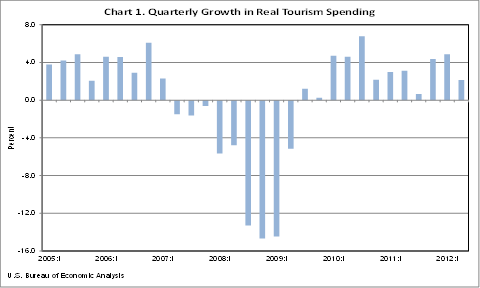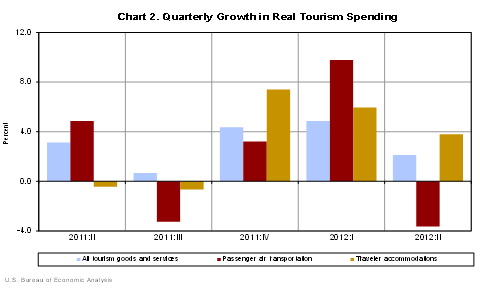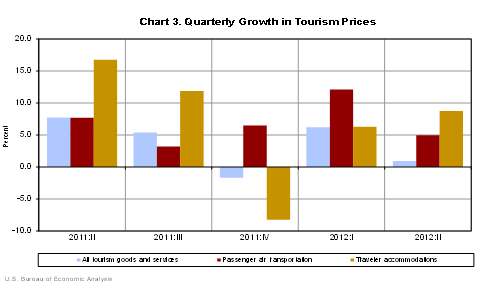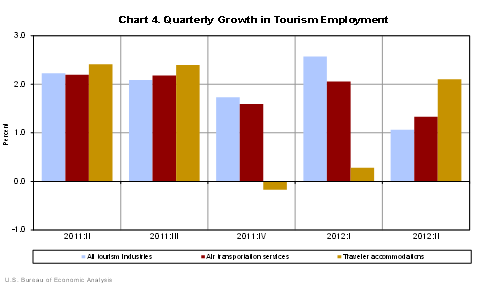News Release
Travel and Tourism Satellite Accounts, 2nd quarter 2012
Real spending on travel and tourism increased at an annual rate of 2.1 percent in the second quarter of 2012 after increasing 4.9 percent (revised) in the first quarter. By comparison, growth in real gross domestic product (GDP) increased 1.7 percent (second estimate) in the second quarter of 2012 after increasing 2.0 percent in the first quarter.
The increase in real spending on tourism reflected increases in all other transportation-related commodities and in traveler accommodations. These increases were partially offset by a decrease in passenger air transportation. The deceleration in real spending on travel and tourism primarily reflected a downturn in passenger air transportation and a deceleration in traveler accommodations, which were partially offset by an acceleration in all other transportation-related commodities.
Overall growth in prices for travel and tourism goods and services slowed, increasing 0.9 percent in the second quarter of 2012 following a 6.2 percent (revised) increase in the first quarter. The second quarter deceleration in prices for travel and tourism goods and services primarily reflected a downturn in gasoline prices, a major input into all transportation services. This downturn was partially offset by an acceleration in the price for traveler accommodations.

Employment in the travel and tourism industries increased 1.1 percent in the second quarter of 2012 after increasing 2.6 percent (revised) in the first quarter. By comparison, overall U.S. employment increased 1.0 percent in the second quarter after increasing 2.1 percent in the first quarter.



Total Tourism-Related Spending in the U.S. includes the goods and services that are purchased directly by tourists and also a portion of the goods and services produced by the supply chain that supports tourism activity; for example, a firm that supplies linens to hotels and restaurants.
In the second quarter of 2012, total current-dollar tourism-related spending was $1.4 trillion and consisted of $858.5 billion (60 percent) of direct tourism spending goods and services sold directly to visitors and $583.5 billion (40 percent) of indirect tourism-related spending goods and services used to produce what visitors buy.
Total Tourism-Related Employment was 7.6 million jobs in the second quarter of 2012 and consisted of 5.4 million (71 percent) direct tourism jobs jobs where workers produce goods and services sold directly to visitors and 2.2 million (29 percent) indirect tourism-related jobs jobs where workers produce goods and services used to produce what visitors buy.
Definitions
Tourism spending. Tourism spending comprises all goods and services purchased by tourists (defined as people who travel for any reason). In the following tables, tourism spending is referred to as direct tourism output.
Indirect tourism-related spending. Indirect tourism-related spending comprises all output used as inputs in the process of producing direct tourism output (e.g., toiletries for hotel guests and the plastic used to produce souvenir key chains).
Total tourism-related spending. Total tourism-related spending is the sum of direct tourism spending and indirect tourism-related spending.
Direct tourism employment. Direct tourism employment comprises all jobs where the workers are engaged in the production of direct tourism output (such as hotel staff, airline pilots, and souvenir sellers).
Indirect tourism-related employment. Indirect tourism-related employment comprises all jobs where the workers are engaged in the production of indirect tourism-related output (e.g., employees of companies that produce toiletries for hotel guests and the plastic used to produce souvenir key chains).
Total tourism-related employment. Total tourism-related employment is the sum of direct tourism employment and indirect tourism-related employment.
These statistics are from BEAs Travel and Tourism Satellite Accounts (TTSAs), which are supported by funding from the Office of Travel and Tourism Industries, International Trade Administration, U.S. Department of Commerce. The current-price statistics of direct tourism output were derived from BEAs annual TTSAs and from current-price quarterly statistics of personal consumption expenditures from the National Income and Product Accounts (NIPAs). The real statistics of direct tourism output were developed using price indexes from the Bureau of Labor Statistics (BLS) and real quarterly statistics of personal consumption expenditures from the NIPAs. The statistics of direct tourism employment were derived from the annual TTSAs (revised in June 2012) from BEA, the Quarterly Census of Employment and Wages (QCEW), and Current Employment Statistics (CES) from BLS.
Quarterly statistics are seasonally adjusted and expressed at annual rates, unless otherwise specified. Percent changes are calculated from unrounded data and annualized. Real values are in chained (2005) dollars. Price indexes are Fisher chain-type measures. Growth in overall U.S. employment is calculated using BLS total nonfarm employment from Current Employment Statistics, www.bls.gov/ces/home.htm#data.
* * *
Next release Travel and Tourism statistics for third quarter 2012 will be released on Monday, December 17, 2012 at 8:30 A.M. EST.
BEAs national, international, regional, and industry statistics; the Survey of Current Business; and BEA news releases are available without charge on BEAs Web site at www.bea.gov. By visiting the site, you can also subscribe to receive free e-mail summaries of BEA releases and announcements.